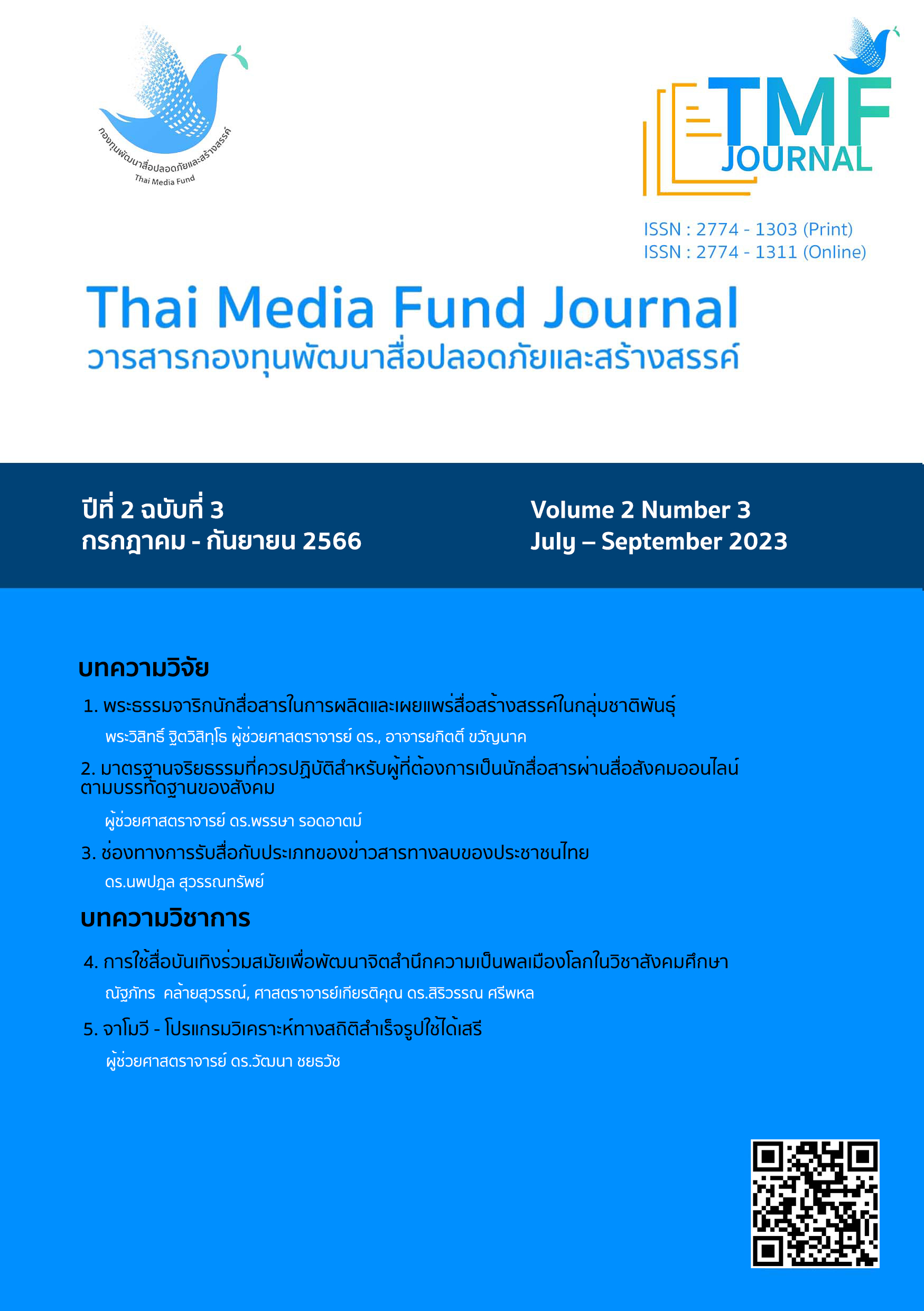ช่องทางการรับสื่อกับประเภทของข่าวสารทางลบของประชาชนไทย
Main Article Content
บทคัดย่อ
งานวิจัยนี้มีวัตถุประสงค์ เพื่อ 1) สำรวจช่องทางการรับสื่อสังคมของประชาชนไทยที่เผยแพร่ข่าวสารทางลบ 2) สำรวจประเภทข่าวสารทางลบที่ได้รับของประชาชนไทย และ 3) ศึกษาเปรียบเทียบความแตกต่างระหว่างเพศกับประเภทข่าวสารทางลบที่ได้รับ ใช้แบบแผนการวิจัยวิจัยเชิงปริมาณ เก็บรวบรวมข้อมูลด้วยการสำรวจออนไลน์ผ่านระบบ Google Form จากประชาชนไทย จำนวน 1,118 คน ทั่วทุกภูมิภาคของประเทศไทย โดยใช้การสุ่มอย่างง่าย ผลการวิจัยพบว่า 1) ช่องทางการรับสื่อของสังคมของประชาชนไทย สูงสุด 3 อันดับ ได้แก่ Line, Line กลุ่ม ร้อยละ 96.0 Facebook ร้อยละ 94.6 และ YouTube ร้อยละ 89.4 2) ประเภทข่าวสารทางลบที่ประชาชนชาวไทยรับข่าวใน 10 ข่าวไม่มีข่าวใดอยู่ในระดับมาก-มากที่สุด และ 3) การเปรียบเทียบประเภทข่าวสารที่ได้รับแล้วทำให้ส่งผลกระทบทางลบ จำแนกตามเพศ พบว่า เพศหญิงมีแนวโน้มที่จะวิตกกังวลสูงกว่าเพศชายเกี่ยวกับข่าวสารประเภท 1) ข่าวภัยพิบัติทางธรรมชาติ 2) ข่าวอุบัติเหตุ 3) ข่าวเศรษฐกิจ ธุรกิจ อุตสาหกรรม เกษตรกรรม ตลาดหุ้น การเงิน การธนาคาร แรงงาน 4) ข่าวอาชญากรรม และ 5) ข่าวเพลิงไหม้ ในขณะที่เพศชายมีแนวโน้มที่จะวิตกกังวลสูงกว่าเพศหญิงเกี่ยวกับข่าวสารประเภท 1) ข่าวสังคม 2) ข่าวการเมือง 3) ข่าวศาล 4) ข่าวบันเทิง และ 5) ข่าวกีฬา
Article Details

อนุญาตภายใต้เงื่อนไข Creative Commons Attribution-NonCommercial-NoDerivatives 4.0 International License.
เอกสารอ้างอิง
Bovet, A., Makse, H. A., & Caldarelli, G. (2019). Network theory of misinformation in online social networks. Proceedings of the National Academy of Sciences, 116(6), 1976-1983.
Dawson, R. (2010, October 8). Newspaper extinction timeline. Retrieved from https://rossdawson.com/frameworks/ newspaper-extinction-timeline/
Friggeri, A., Adamic, L. A., Eckles, D., & Cheng, J. (2014). Rumor cascades. In Proceedings of the Eighth International Conference on Weblogs and Social Media, (pp. 101-110.)
Phongpho, S., & Benjarongkit Yubol, (2021). Communication formats and concepts of news operations related to national security in politics through online media. Journal of Communication Arts, 39(1), 121-137.
Ramasoota, P. (2022). Digital platform: Analysis from an economic perspective. Thai Media Fund Journal, 1(2),
-39.
Rodyoo, C. (2020). News in digital media era. Parichart Journal Thaksin University, 33(2), 16-33.
Sasiroj, K. (2022). Digital age: Newspapers organization management. Journal of Business Administration and Languages (JBAL), 10(2), 46-63.
Thongna, N. (2022). Thai and world economic trend in 2023 and guidelines for dealing with the impact of the global crisis on the manufacturing industry in Thailand. Retrieved from https://www.nectec.or.th/news/news-article/economy-industry.html
Trisukon, P., Manin, W., & Vaiyavasana, R. (2020). Principle of communication art. Suansunandha Rajabhat University. Source: http://www.aritbooks.nrru.ac.th/uploadfiles/books/2-2018-08-30-08-38-59.pdf
Vosoughi, S., Roy, D., & Aral, S. (2018). The spread of true and false news online. Science, 359(6380), 1146-1151.
Wongwitit, S. (2022). Legal measures and media literacy to fight disinformation. Thai Media Fund Journal, 1(3), 1-33.


